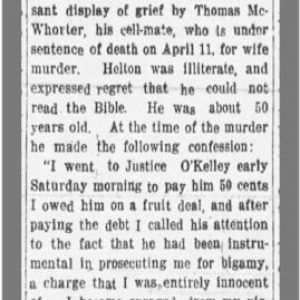calsfoundation@cals.org
Kit Helton (Execution of)
Kit Helton was hanged on March 7, 1902, for murdering his wife—the first of three executions conducted at Van Buren (Crawford County) in 1902.
Kit Helton, fifty-five, was a farmer living with his wife Ella near Lancaster (Crawford County). Helton suspected his wife was having an affair with Justice of the Peace John O’Kelley. On September 28, 1901, Helton rode to O’Kelley’s house and paid him fifty cents he owed him over some business. Helton said, “That settles our fruit deal; I will also settle another score with you,” before pulling a pistol and shooting him in the abdomen. Initial reports said O’Kelley was killed, but he survived his wounds.
Helton then rode home and called his wife out of their house, where he “shot…through the heart, killing her instantly.” Reports said that he then went searching for his stepson Brush Steward, intent on murdering him, but instead fled into the mountains. A posse located him, and a firefight broke out in which Helton was wounded in the arm. When his gun malfunctioned, he surrendered and was taken to the Van Buren jail under tight security as lawmen prepared for a possible lynch mob.
Helton waived a preliminary hearing on October 3 and was remanded to the November term of the Crawford County circuit court. He was soon reported as being sick in his jail cell, not eating, and “evidently suffering from an attack of dementia.” Helton’s brother hired “the well known criminal lawyer” Berkeley Neal to represent him, and they apparently sought an insanity defense, but a special grand jury determined that he was sane.
He was tried at the beginning of January 1902, and the jury, after deliberating for two hours, found him guilty of first-degree murder. It was reported that “Helton showed no signs of fear when the verdict was read.” A few days later, he was sentenced to hang and, when asked “if he had any complaint to make,” replied, “No, I killed Ella, and do not dread the scaffold.”
Another wife killer, Dave McWhorter, was placed in the same cell as Helton a few weeks later. A newspaper reported that McWhorter “grasps and shakes the iron bars and cries that he cannot escape,” while Helton “sits by and laughs at McWhorter’s display of grief.” Helton was initially sentenced to hang on February 7, 1902, but Governor Jeff Davis granted Helton a thirty-day reprieve while Neal applied to have the sentence commuted.
As Sheriff James Pitcock contracted to have gallows built on the Crawford County Courthouse square in early March 1902, a reporter stated that Helton “broke down and cried.…[T]he condemned man has realized…that he has but a short time to live unless granted a commutation.” A preacher visited his cell, but Helton said that “the jail is no place to start religion or join the church” and that he “feels that he has been forgiven and…has no fears.”
Helton enjoyed a hearty breakfast on the morning of March 7, 1902. Governor Davis called Pitcock at 9:00 a.m., ordering him to hold off on the execution, only to call back thirty minutes later to tell him to proceed with the hanging.
Surrounded by lawmen, Helton left his cell at 10:12 a.m., and “a solid mass of men and boys, with a scattering of women, lined the way from the jail to the enclosure, and as Helton passed through he nodded to acquaintances.” One thousand people had applied for tickets to enter the enclosure and watch Helton die, but only twenty-five witnesses, along with reporters and doctors, were allowed in.
“Helton was pronounced the coolest man that was ever seen on the scaffold here,” one journalist wrote, adding that “he walked unaided to the scaffold, rather pale, but showing no other signs of fright.” At 10:18 a.m., Pitcock triggered the trap door, and Helton “dropped seven feet, breaking his neck completely.” The Fort Smith Times reported that “the body never quivered, every muscle was tense and remained so to the end.” Declared dead at 10:34 a.m., Helton’s body was placed in a pine box and buried in Fairview Cemetery at the county’s expense.
Two other men would die in Van Buren in 1902 on the same scaffold as Helton—Dave McWhorter on July 25 and rapist Hall Mahone on November 7.
For additional information:
“Arkansas Happenings.” Arkansas Gazette, March 4, 1902, p. 8.
“Building Scaffold.” Arkansas Democrat, March 3, 1902, p. 1.
“Cold Blooded Fiend.” Fort Smith Times, October 2, 1901, p. 1.
“Double Tragedy Near Van Buren.” Arkansas Gazette, September 29, 1901, p. 3.
“Helton Breaking Down.” Fort Smith Times, October 29, 1901, p. 2.
“Helton Hanged.” Arkansas Democrat, March 7, 1902, p. 1.
“Helton Hanged.” Fort Smith Times, March 7, 1902, p. 1.
“Killed His Wife.” Fort Smith Times, September 30, 1901, p. 1.
“Kit Helton.” Arkansas Democrat, January 31, 1902, p. 7.
“Kit Helton Convicted.” Fort Smith Times, January 3, 1902, p. 4.
“Kit Helton Murder Case.” Fort Smith Times, November 22, 1901, p. 4.
“Kit Helton Sane.” Arkansas Democrat, January 1, 1902, p. 3.
“Kit Helton Will Hang.” Fort Smith Times, January 6, 1902, p. 4.
“O’Kelley Will Recover from Pistol Shot Wound.” Arkansas Gazette, October 1, 1901, p. 6.
“State News.” Arkansas Democrat, January 18, 1902, p. 5.
“A Wife Murderer to Hang April 11.” Arkansas Gazette, February 13, 1902, p. 3.
“Without Bond.” Arkansas Democrat, October 3, 1901, p. 1.
Mark K. Christ
Central Arkansas Library System
 Early Twentieth Century, 1901 through 1940
Early Twentieth Century, 1901 through 1940 Law
Law Kit Helton Exectution Article
Kit Helton Exectution Article 



Comments
No comments on this entry yet.